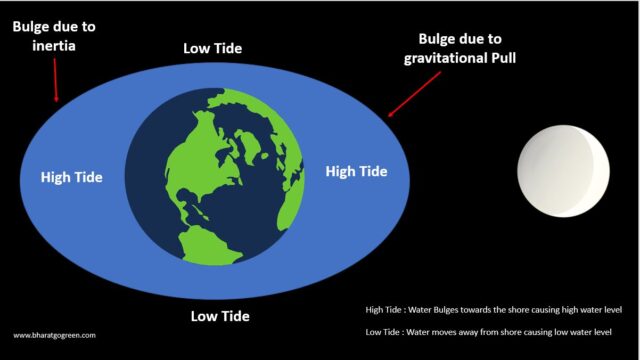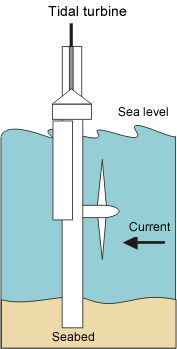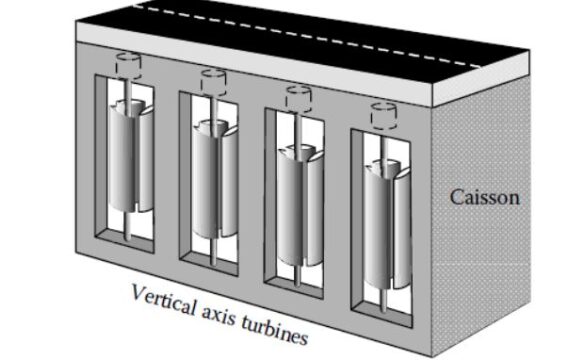Tidal Energy is the most promising and cleanest source of energy that is available in abundance.
With the growing energy demand and rapid depletion of fossil fuels, it is now necessary to explore some new forms of renewable energy.
The energy harnessed from oceans ranks among the top of all sustainable and renewable energy sources.
Energy from the tides can be predicted more accurately than wind or sun due to the massive size of oceans.
Do you know that it is possible to generate electricity from the natural rise and fall of the oceanic tides?
Tidal power production is still in the nascent stage and the amount of electricity produced so far has been quite small.
To date, there are very few tidal power plants operating commercially but the process is slowly gaining traction.
Although, Oceans are available in plenty but harnessing the power from them is no easy task as it suffers from huge investment and limited site availability.
In this article, we will discuss the importance, use, advantages, and disadvantages of tidal energy.
What is Tidal Energy | How Tides are Produced?

Tidal energy is a type of renewable energy produced by ocean movement during the rise and fall of currents.
Tidal currents of large water bodies result from the gravitational pull of the sun and moon acting on these water bodies.
However, lunar tides caused due to the moon’s gravitational force have greater influence as the moon is located much nearer to the earth.
The intensity of tides at any location depends upon:-
- The changing position of sun and moon with respect to the earth
- Earth’s rotation
- local geography of the coastline
- Weather patterns such as wind and pressure (less effect)
The rise and fall of ocean water occur twice in a lunar day (as high & low tides), thus tidal energy is continuously available and predictable.
Alternating water currents generate a high amount of power compared to air even at low velocity, as water is denser than air.
How Tidal Energy is Harnessed?
The gravitational forces (described above) create a massive amount of moving water every day.
These moving currents contain enormous kinetic energy that one can harness for power production.
Tidal waves also contain potential energy at a point when water is at a higher elevation than the normal.
A tidal stream turbine is a device used to convert the kinetic energy of the moving water into electrical energy.
Tidal Power plants can only be installed across the coastlines as they receive 02 high & low tides in a day.
There are three different ways to harness the power of tidal energy.
1. Tidal Barrages
Tidal barrages are just like dams used for hydropower generation, but they are a lot bigger in size as they are built across a bay.
They are the most efficient ones as the turbine employed in tidal barrages is bi-directional, and they can generate power during high and low tide.
In a conventional dam, water can flow only on one side but in a tidal barrage, water can flow from sea to a bay (or estuary) as well as from bay to sea.
The difference in water levels (between high & low tide) must be above 5m height to produce electricity.
But how is this possible?
Let’s discuss the two cases.
Case-I : High Tide Scenario
During high tide, the sea level rises, and the tidal energy is channelized through the dams to flow towards a bay or estuary.
As the water passes through the dam, the turbine generators attached to the channels start rotating, which converts the tidal energy into electrical power.
Case-II : Low Tide Scenario
During low tide, the sea level falls, and it goes below the level of water stored in an estuary.
In this condition, the direction of the turbine blades is reversed and due to height difference, water starts flowing towards the sea.
Again the turbine generator starts rotating and producing electricity.
There are very few plants in the world based on this technology as the upfront capital cost is high and they have an adverse impact on the environment.
Sihwa Lake Tidal power plant in South Korea is the largest tidal power plant having a generation capacity of 254 MW.
2. Tidal Energy Turbines

Tidal turbines are very similar to wind turbines or windmills but they operate underwater.
They are installed at potential sites having an ocean depth of 35 m or above for optimum performance.
Water currents turn the turbine blades that ultimately rotate the generator connected through a shaft and electricity is produced.
Tidal energy turbines are the simplest, cheapest, and the least ecologically damaging among all power generation technologies.
However, there is a limitation that it produces less power as compared to others.
3. Tidal Fences

Tidal Fences are similar to tidal turbines but installed in the vertical direction.
These turbines are mounted in a fence that is placed on the sea bed.
As the seawater passes through the turbine blades tidal energy is converted to electrical power.
Tidal fences can generate electricity by utilizing both the incoming and outgoing tides.
Advantages and Disadvantages of Tidal Energy
Following are the tidal energy advantages and disadvantages:-
Advantages of Tidal Energy
1. Environment Friendly
Tidal energy is a completely clean energy source as it does not emit any dangerous greenhouse gases into the atmosphere.
Conventional fossil fuels contribute to air pollution, whereas tidal power leaves no by-products.
Tidal energy application creates less noise too as the sound is transmitted through water.
2. Predictable & Reliable
One of the biggest advantages of tidal energy is that currents are highly predictable, making it easier to build tidal energy systems correctly and efficiently.
This predictability makes tidal energy a better option than wind power, which is far less dependable.
Normally two high and low tides occur in a day, and some systems can harvest power from tidal currents regardless of any direction they are flowing.
3. Renewable
Gravitational forces of the sun, moon, and earth along with earth’s rotation creates tidal energy.
It is a natural process occurring every day and it is almost impossible to deplete this process that controls the tides.
So, renewability is the biggest advantage of tidal energy.
4. Tidal Energy is Effective at Low-Speed
Water is almost a thousand times denser than air, so the ocean currents can generate electricity even at low speeds.
Tidal turbines can generate electricity at a speed as low as 1 m/s whereas most wind turbines are effective over a wind speed of 3 m/s.
5. Offers Protection
Barrages and dams that are built along the seashore can protect the nearby coastal areas from dangerous tides occurring during bad weather conditions.
6. Cost-Effective
Tidal power plants have a longer life span and once constructed, they can produce electricity for many years.
The initial upfront cost may be higher but the return on investment is assured in the long run.
Thus tidal power plants are more cost-effective, easy to maintain, and economical when implemented on a large scale.
The life-span of various power plants are:-
- Tidal Power Plants – 75 to 100 years
- Solar Power Plants – 40 years
- Wind Power Plants – 20 to 25 years
- Nuclear Power Plant – 60 years
7. Reduce dependency on Foreign Imports
Harnessing the energy of tides can reduce dependence on imported energy supplies & increasing national energy security.
8. Economic Development
Installation and operation of tidal energy systems can help create local employment, thus boosting the Nation’s overall economic development.
9. High Efficiency
A tidal power plant’s efficiency is 85-90%, which is much more efficient than any coal, solar, or wind power plants.
There are no energy conversion losses and the head is available very near to turbine blades resulting in high efficiency.
The efficiency of various type of power plants are:-
- Coal Power Plant – 32 to 42%
- Natural Gas Power Plant – 32 to 38%
- Wind Power Plants – 35 to 45%
- Solar Power Plants – 20%
- Thermal Power Plants – 35%
- Nuclear Power Plants – 38%
10. Installed on Large Scale
Almost 71% of the earth’s surface is covered by water, so it is possible to harness tidal energy on a large scale.
Disadvantages of Tidal Energy
1. Tidal Energy is not a Constant Energy Source
Tidal Energy depends upon the motion and flow of water, which depends on the gravitational forces of the celestial bodies.
Thus, the tides’ energy is not a constant energy source due to intermittent power generation (an average of 10 hours per day).
2. High Upfront Capital Cost
One of the biggest disadvantages of tidal power is that it is a new technology thus the initial infrastructure cost is relatively high.
Although long-term generation cost is low as compared to other renewable systems but due to the high initial cost much investment is not taking place.
Due to the high upfront cost, India has canceled its two proposed tidal power plants in Gujarat and West Bengal.
3. Environmental Impact
Research is going on to access the potential environmental impact of tidal energy systems, some of them are:-
- Tidal barrages manipulate sea levels which is detrimental for the aquatic ecosystem.
- Electromagnetic emissions can disrupt marine life.
- Noise during the construction phase.
- Sediment deposition and substrate alteration
In the near future, we may see some new technological advancements that will resolve these issues.
Although seawater is available in abundance, every shore is not suitable for tidal power production which is another limitation of tidal energy
Efficient Operation requires a very precise and specific calculation that is difficult to meet.
For example, the difference in water levels between high & low tide must be above 5m height to produce electricity which may not be possible at certain locations.
5. A Novel Technology
Power generation using tidal energy is an emerging concept which needs extensive research and funds.
Conclusion
Tidal energy has many advantages but some disadvantages too.
Tidal power is indeed more reliable than solar or wind, but the high capital cost restricts its development soon.
This industry is new and needs more research, but tidal power generation will become cheaper with ongoing investment and expertise.
What do you think about tidal power and its usefulness?
Please provide your comments below and share this article to help others.
To join the Save Environment bandwagon consider subscribing bharatgogreen.
References: